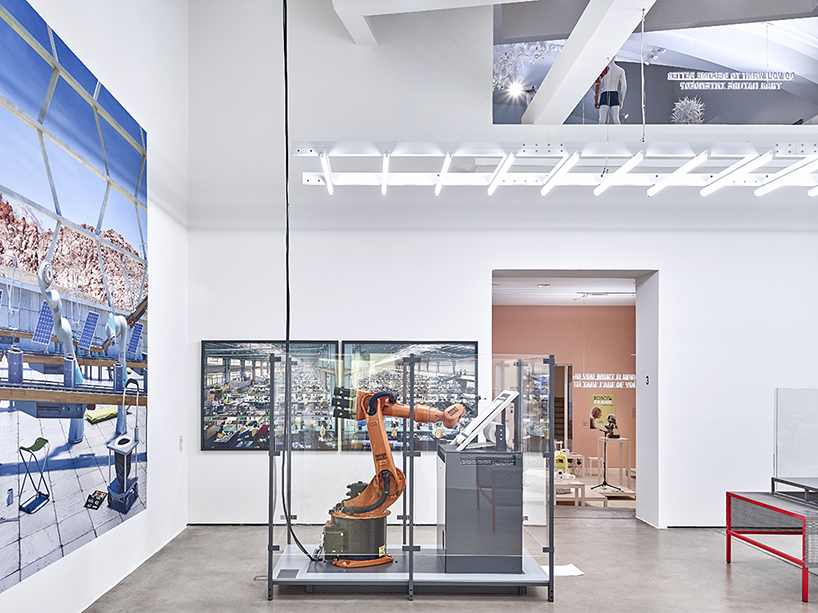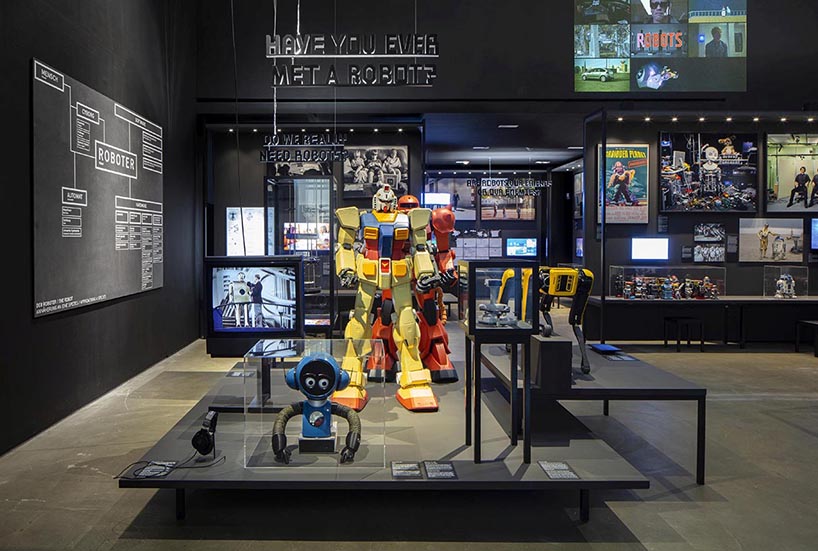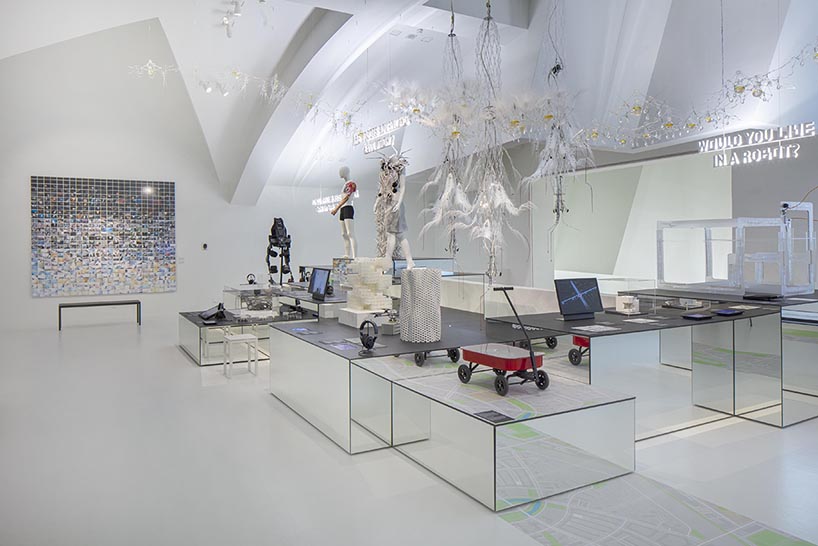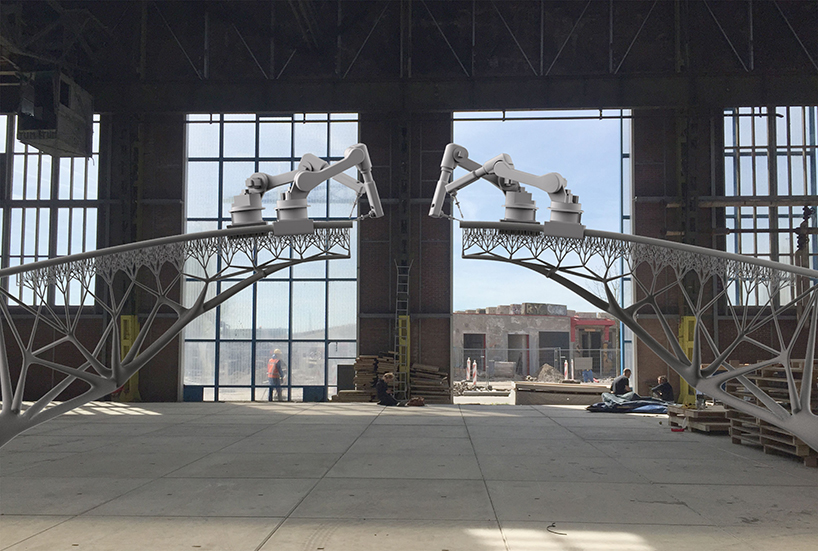‘hello, robot’ returns to vitra design museum with an expanded set of questions
‘Hello, Robot. Design between Human and Machine’
The successful exhibition ‘Hello, Robot. Design between Human and Machine’ has just returned to the Vitra Design Museum after touring the world for five years. This time, the exhibition is curated like a journey in four thematic sections with an expanded catalog of questions. Starting with a very distant perspective, each section brings the audience closer to the moment humans and robotics become one. Although in those five years, our world has become even smarter and technology even more autonomous, the exhibition re-examines the technological breakthroughs along with fourteen questions that raise awareness about the responsibility of design.

‘Hello, Robot. Design between Human and Machine’ installation view | image © Mark Niedermann
a four-part thematic exploration of robotics
Arranged like a cabinet of curiosities, the installation of the first section is meant to create a facetted perspective on robots. Answering the first question, ‘Have you ever met a robot?’, one might say ‘No,’ thinking robots are elements of pure fiction. First introduced in the 1920s by the Čapek brothers in their theatre play R.U.R. (Rossum’s Universal Robots), our understanding of robots has changed very little over the past hundred years: these machines either serve us or destroy us.
Moving away from this binary utopian/dystopian narrative, the exhibition’s real-world robotics designers offer a multi-faceted discourse. By juxtaposing famous robots from fiction like the original R2-D2 from Star Wars with the real-world example of ‘Spot’ by Boston Dynamics, the audience learns that they can encounter various forms of robots in daily life already today, even more often than we are aware of. Vitra Design Museum curator Amelie Klein offers a new definition: ‘Anything can be a robot. All it needs are three elements: sensors to receive data; intelligence enabling it to successfully process these data; and actuators allowing it to generate an appropriate physical response.’

installation view 2 | image © Ludger Paffrath
The second section showcases the realm of working environments and discusses the boundaries of today’s human labor. The photographs of Edward Burtynsky depict a reality in Xiamen City, China, where thousands of people work in an assembly-line factory the size of four soccer fields. Against that backdrop, robotlab’s one-armed industrial automaton writes manifestos, the CurVoxels 3D-printed cantilever chair makes furniture factories obsolete, and the MX3D Bridge attests to technological breakthroughs enabling 3D-printed 1:1 architectural elements.
Complementing that exploration of digital fabrication is the ‘Eggshell Pavilion’ installation by Gramazio Kohler Research, ETH Zurich. The project showcases new digital production methods and discusses their effect on architectural design and sustainability development. This section’s question, ‘Could a Robot do your job?’, opens up new discussion points: What kind of jobs do we leave for humans, and what kind of jobs do we leave for robots? What is the ultimate value of labor provided by robots?

installation view 3 | image © Ludger Paffrath
The exhibition’s third section embraces ambivalence, whereby showcased works no longer discuss the relationship between man and machine. Instead, posed questions examine how our perception of technology has evolved. Speculative design projects like ‘Raising Robotic Natives’ by Stephan Bogner, Philipp Schmitt, and Jonas Voigt and ‘CremateBot’ by Dan Chen show a world in which robots are potentially our friends and helpers from the cradle to the grave.
Meanwhile, the real-world example of Sony Corporation‘s discontinued ‘AIBO’ series reveals the dog-shaped robot as more than just a digital companion; excerpts from ‘The Family Dog’ by Zackary Canepari and Drea Cooper show how Aibo’s owners’ grief equates that to a real dog. ‘This section mirrors that technology ultimately shapes the relationship and interaction between humans. If we already live in a robotic world, have humans and robots already become one?’ explains Vitra Design Museum.

Joris Laarman for MX3D, ‘Bridge Project’, 2015, 3D-printed pedestrian bridge © Joris Laarman
Finally, the fourth section explores the fusion between humans and technology and how both shape one another. Even though the displayed objects and prototypes already announce a near future in which fiction can become a reality, they echo the limits we have reached today. This last section proves that technology is never neutral, as human-based creations always carry the agenda and values of their creator. The journey ends with the ‘Eggshell Pavilion’ installed in front of the museum. Against the backdrop of large black letters on top of Gehry‘s white Vitra Design Museum facades, the initial question at the entrance is viewed from another angle: ‘Do you trust robots?’
‘With the final question, we learn that the discussion is not about whether robotics serves us or whether it destroys us, but rather how we want to shape our world with the tools that technology gives us. ‘Hello, Robot’ encourages visitors to find their own answers and pose new questions. The journey will continue in our daily lives as it raises awareness about our collective responsibility,’ concludes the museum.
The ‘Hello, Robot. Design between Human and Machine’ exhibition was organized by Vitra Design Museum jointly with MAK – Museum of Applied Arts and Design Museum Gent. Launched on September 24, 2022, the show will run until March 5, 2023, at the Vitra Design Museum in Germany.

